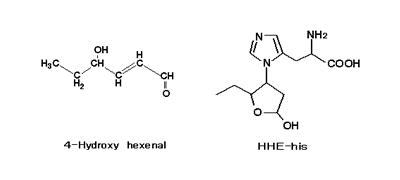 |
Oxidative Stress
Rev.070713 |
Anti-4-hydroxy-2-hexenal monoclonal antibody
(Anti 4-HHE monoclonal antibody, clone HHE53) |
|
| About 4-hydroxy-2-hexenal (4-HHE) |
|
4-hydroxy-2-alkenal is one of the major lipid peroxidation products, and shows many biological effects
such as high toxicity to cells. Among them, 4-hydroxy-2-hexenal (HHE) is an aldehyde formed during
peroxidation of n-3 fatty acids such as docosahexaenoic acid. HHE is highly reactive aldehyde and reacts
with histidine residue of protein to form Michael-addition type adducts. This antibody is specific for HHE-histidine
Michael adduct (HHE-His) and enable to detect HHE-His in the tissue samples.
|
 |
|
| Specifications |
| Clone #: |
HHE53 |
| Antigen: |
HHE-modified keyhole-lympet hemocyanine |
| Specificity: |
Specific for HHE-modified protein (especially HHE-His Michael adduct) |
| Subclass: |
Mouse IgG1 kappa
Prepared as ascite, and protein-A purified. |
| Form: |
Frozen in 10mM PBS containing 0.1% NaN3 and 0.5% BSA. |
| Application: |
Immunohistochemistryˇ¨It is recommended that the antibody be tried at 0.5-1.0 µg/mL on
paraformaldehyde fixed tissue. |
| Storage: |
Less than -20°C |
|
| Product name |
Code |
Content |
| Anti 4-HHE monoclonal antibody |
MHH-030n |
30 µg IgG |
|
Manufactured by NOF corporation, Japan. |
| FOR RESEARCH USE ONLY. Not for diagnostic, medical or other use. |
| Procedure |
| 1) |
Paraffin sections were deparaffinized and rehydrated. |
| 2) |
Sections were quenched for several minutes with 3% hydrogen peroxide,
rinsed in PBS, pretreated for 30 min with 3% nonimmune animal serum in PBS. |
| 3) |
Sections were incubated overnight at 4°C with a antibody at a
dilution of 1 micro gram/mL. |
| 4) |
Antibody binding was visualized by the avidin-biotin-immuno
peroxidase complex method using the Vectastain ABC kit (Vector, Burlingame, CA) according to the manufacturer's instructions. |
| 5) |
3,3-Diaminobenzidine tetrahydrochloride was used as the chromogen. |
| 6) |
Hematoxylin or Eosin was used as the counter stain. |
|
| Technical Note |
| 1) |
Sections from which the primary antibodies were omitted served as
negative reaction controls. |
| 2) |
For frozen materials, samples were fixed in 10% formalin,
immersed in 30% sucrose in PBS, embedded at OCT (Sakura, Tokyo, Japan), and stored at 80°C. |
| 3) |
For paraffin embedded materials, samples were fixed in 10% formalin,
dehydrated, embedded in paraffin, and stored at room temperature. |
| 4) |
Microwave treatment improves the target staining, whereas it
declines non-specific background. |
| 5) |
Protease K treatment declines the target staining. |
|
| Positive control |
| |
Aortic wall in the renal tissue of diabetic nephropathy or
aortic wall of atherosclerosis. |
|
|
| 1) |
Protein-bound 4-hydroxy-2-hexenal as a marker of oxidized n-3
polyunsaturated fatty acids.
Yamada S, Funada T, Shibata N, Kobayashi M, Kawai Y, Tatsuda E, Furuhata A, Uchida K.
J Lipid Res. 45(4), p626-634 (2004) |
| 2) |
Accumulation of protein-bound 4-hydroxy-2-hexenal in spinal cords
from patients with sporadic amyotrophic lateral sclerosis.
Shibata N, Yamada S, Uchida K, Hirano A, Sakoda S,
Fujimura H, Sasaki S, Iwata M, Toi S, Kawaguchi M, Yamamoto T, Kobayashi M
Brain Res. 1019(1-2), p170-177 (2004) |
|
| FOR RESEARCH USE ONLY. Not for diagnostic, medical or other use. |
|
